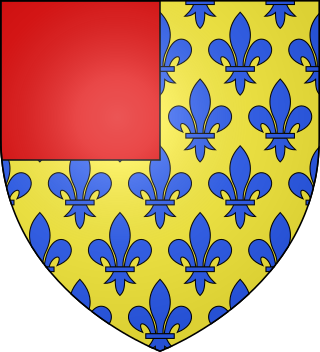
The Duchy of Brittany was a medieval feudal state that existed between approximately 939 and 1547. Its territory covered the northwestern peninsula of Europe, bordered by the Atlantic Ocean to the west, and the English Channel to the north. It was also less definitively bordered by the river Loire to the south, and Normandy, and other French provinces, to the east. The Duchy was established after the expulsion of Viking armies from the region around 939. The Duchy, in the 10th and 11th centuries, was politically unstable, with the dukes holding only limited power outside their own personal lands. The Duchy had mixed relationships with the neighbouring Duchy of Normandy, sometimes allying itself with Normandy, and at other times, such as the Breton-Norman War, entering into open conflict.
Geoffrey I, also known as Geoffrey of Rennes and Geoffrey Berengar, was the eldest son of Duke Conan I of Brittany. He was Count of Rennes, by right of succession. In 992 he assumed the title of Duke of Brittany, which had long been an independent state, but he had little control over much of Lower Brittany.

Odo of Rennes, Count of Penthièvre, was the youngest of the three sons of Duke Geoffrey I of Brittany and Hawise of Normandy, daughter of Richard I of Normandy. Eudon married Agnes of Cornouaille, the daughter of Alan Canhiart, Count of Cornouaille and sister of Hoel II, Duke of Brittany who was married in 1066 to Eudon's niece Hawise, Duchess of Brittany.

Alan III of Rennes was Count of Rennes and duke of Brittany, by right of succession from 1008 to his death.

Conan II of Rennes was Duke of Brittany, from 1040 to his death. Conan was the eldest child and heir of Alan III, Duke of Brittany by his wife Bertha of Blois, and member of the House of Rennes. He was the elder brother of Hawise, who succeeded him as suo jure duchess.

Alan IV was Duke of Brittany from 1072 until his abdication in 1112. He was also Count of Nantes and Count of Rennes. His parents were Duchess Hawise and Duke Hoel II. He is also known as Alan Fergant. Through his father, he was of the Breton House of Cornouaille dynasty. He was the last Breton-speaking Duke of Brittany.

Fulk III, the Black, was an early count of Anjou celebrated as one of the first great builders of medieval castles. It is estimated Fulk constructed approximately 100 castles, along with abbeys throughout the Loire Valley in what is now France. He fought successive wars with neighbors in Brittany, Blois, Poitou and Aquitaine and made four pilgrimages to Jerusalem during the course of his life. He had two wives and three children.
Conan I, nicknamed Le Tort, was the Duke of Brittany from 990 to his death.

Ralph de Gaël was the Earl of East Anglia and Lord of Gaël and Montfort. He was the leading figure in the Revolt of the Earls, the last serious revolt against William the Conqueror.
Stephen of Penthièvre, Count of Tréguier, 3rd Lord of Richmond was a Breton noble and a younger son of Odo, Count of Penthièvre and Agnes of Cornouaille, sister of Hoël II, Duke of Brittany. In 1093, he succeeded to the title of Count of Tréguier; in 1098, he succeeded his brother Alain as Lord of Richmond in Yorkshire, England.
The counts of Nantes were originally the Frankish rulers of the Nantais under the Carolingians and eventually a capital city of the Duchy of Brittany. Their county served as a march against the Bretons of the Vannetais. Carolingian rulers would sometimes attack Brittany through the region of the Vannetais, making Nantes a strategic asset. In the mid-ninth century, the county finally fell to the Bretons and the title became a subsidiary title of the Breton rulers. The control of the title by the Breton dukes figured prominently in the history of the duchy. The County of Nantes was given to Hoel, a disinherited son of a duke. He lost the countship due to a popular uprising. That uprising presented an opportunity for King Henry II of England to attack the Breton duke. In the treaty ending their conflicts, the Breton duke awarded the county to Henry II.
The noble Breton family line of Porhoët was a French noble family in the middle ages, from around 990 through the 1200's. Notable members included Odo I, Odo II, and Alan I. Alan I would go on to form the Franco-Breton House of Rohan, which survives to the modern day.
Bertha of Cornouaille, also known as Bertha of Brittany, was the Duchess of Brittany between 1148 until her death and Dowager Countess of Richmond. Bertha was the elder daughter of Conan III of Brittany by Maude, the illegitimate daughter of King Henry I of England. She was the last member of the Breton house of Cornouaille to reign over Brittany.

The Breton–Norman War of 1064–1066 was fought between the sovereign Duchy of Brittany and the Duchy of Normandy.

Aimery IV viscount of Thouars was a companion of William the Conqueror on his Invasion of England in 1066.
The army of Robert Curthose, Duke of Normandy, left for the Holy Land on the First Crusade. Robert was the eldest son of William the Conqueror and brother to William Rufus, king of England. He was reportedly so poor that he often had to stay in bed for lack of clothes. In order to raise money for the crusade he mortgaged his duchy to his brother William II of England. His army joined the contingent of Robert II, Count of Flanders, and Stephen, Count of Blois.
Andrew II of Vitré was Baron de Vitré from 1173 to 1210/11.

The Lordship of Combourg, after 1575 the County of Combourg, was a barony centred on Combourg in the east of the Duchy of Brittany in France during the Middle Ages and the early modern period.








